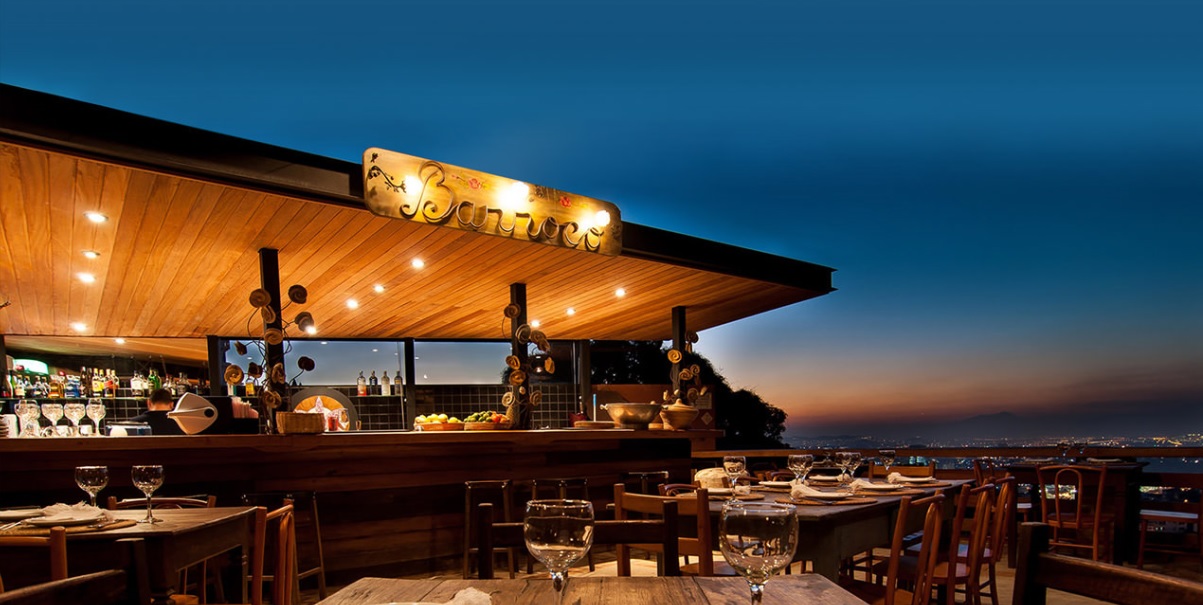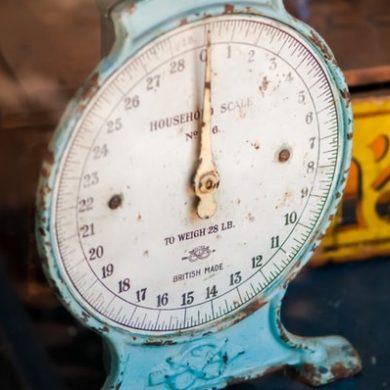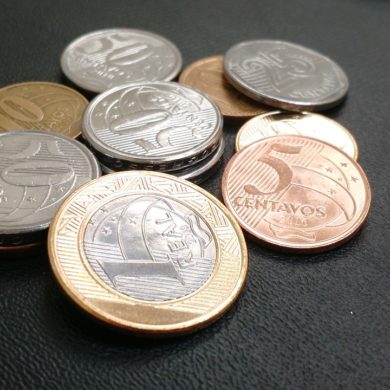Where are the best places to eat? What are the best ways to get around in Brazil? Tipping, taxis, punctuality…these are all classic daily concerns for any traveler in Brazil. After pointing our clients in the right direction for years, we have decided to collect this essential information in a complete Brazil travel guide covering all the Brazilian norms you should be aware of while exploring the country.
Firstly, food! Many of our clients come to Brazil especially to sample its fantastic and unique dishes. This page will cover how meals in Brazil are enjoyed, the different kinds of meals that are popular here and what you can expect when going out to eat with a group of Brazilian people. Furthermore, we describe the culinary specialities of each region so you can be sure to take advantage of each region´s gastronomical expertise.
Secondly, travel. On this page you find the best advice on how to get around whilst you are spending time in the urban areas of Brazil. Finally, a point on the question of tips for drivers and guides during an organized trip or tour.
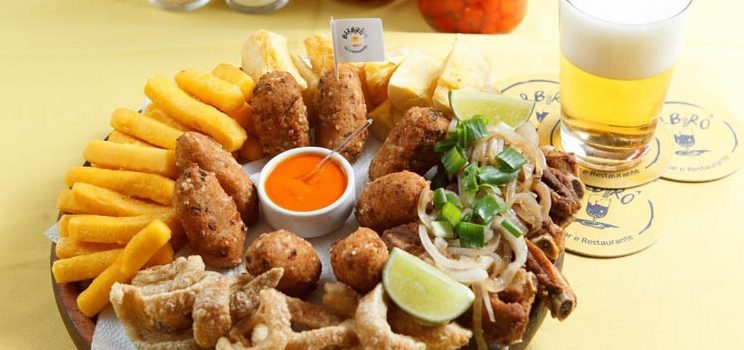
Eating in Brazil
What types of food do people commonly eat in Brazil?
Brazilian people mostly prefer eating larger meals when compared to other cultures and at fixed times throughout the day. Particularly popular here are starchy foods and proteins, similar to most other Latin American countries. In some regions such as The Nordeste, the arid climate is not ideal for cultivating many vegetables. It is common then to replace these lost nutrients with fruit.
Generally, Brazilian people will start the day with a generous breakfast, then often a small sweet or savoury snack in the middle of the morning. The midday meal is the most important nutritionally but also habitually. “Almoço” as it is known in Brazil is the worker´s first break in the day so it is enjoyed fully. Many shops and small businesses will close up to take their lunch hour in peace. A plate of lunch in Brazil will consist of some sort of protein (meat, fish, chicken, fried eggs, sausage) accompanied by the traditional duo of rice and cooked beans, cassava flour and a little salad. In the Northern part of the country, especially in the Nordeste region the plate also has either spaghetti or pasta. People often top the plate off with a sprinkle of chilli sauce.
In the afternoon, a smaller snack such as a fruit smoothie is popular. For dinner something simpler and on the go like a pizza, a hamburger or soup. “Petiscos” (similar to tapas) are the norm if you go out to a boteco (bar). It is common for friends and co-workers to meet up in the evening and go out for an ice-cream or an Açaí sorbet. Açaí is a super food that comes from a palm tree in the Amazon rainforest, it is used to make a delicious and refreshing sorbet packed full of vitamins and nutrients, which has recently exploded in popularity with health gurus and athletes. Sunday noon is often the time for family lunch. It is common for entire families to meet up on a Sunday including grandparents, cousins and other close relations.
Everyday Brazilian cuisine is tasty, simple and generous; expect meats, grilled fish and rice with beans as a staple. Modern restaurants are equipped with quality equipment, and undergo regular hygiene checks. Brazilian restaurants and hotels are very professional from a food hygiene/quality point of view so there is no need to be shy of raw vegetables, salads, fresh juice or seafood.
It is always a good idea to be careful however with street vendors where hygiene may not be up to scratch. There are, all kinds of interesting and delicious street foods to try, but when in doubt, it is better to go for cooked foods such as “salgados”. These are dumplings filled with chicken, meat, cheese or ham. For drinks, always request a sealed bottle or make sure that it has been opened in front of you.
Brazilian breakfast
Any accommodation you book through Brazil Selection is likely to come with breakfast included. It is common for travellers to be pleasantly surprised by some Brazilian breakfast traditions such as the fact that eating cake for breakfast is totally acceptable! Here is what you can expect at the breakfast buffet of your hotel.
Brazilians are used to eating hearty breakfasts that can be either sweet or savoury and cater for all tastes. In hotels the Brazilian breakfast buffet is generally composed of an assortment of scrambled eggs, ham, sausages, tapioca pancakes, butter and different types of bread alongside lots of fresh tropical fruit, cakes, cereals, milk, honey and delicious seasonal fruit juices. Breakfasts in Brazilian hotels differ from continental breakfasts with the addition of the tapioca pancakes and Brazilian couscous (different from what you may think).
All this is washed down with sweet (usually) black coffee. Black tea is rare in Brazil, if you ask for a cup of tea (cha) you could be served an infusion. This can be rather frustrating for some foreign visitors so if you need your tea in the morning, it is certainly easier to bring a few tea bags with you and simply ask for hot water at breakfast.
Portuguese terms for common breakfast items
- Eggs – ovos
- Ham – presunto
- Sausage – salsicha
- Butter – manteiga
- Bread – pão
- Cake – bolos
- Milk – leite
- Honey – mel
- Fruit juice – suco de frutas
- Hot water – agua quente

Pricing and Tips
Most restaurants add 10% tip to the final bill. It is a good idea to have a quick check over your receipt to verify what you have been charged for. Nearly all restaurants in Brazil accept credit cards.
Brazilian people also like to have a little bit of many different flavours on their plates. As a result, all-you-can-eat buffet style restaurants are very popular. They vary in price and quality, simple local eateries to the most sophisticated city restaurants.
As for the prices, you could spend between $6 and $15 per person for lunch and $17 to $25 for dinner in a restaurant (excluding wine, which is expensive in Brazil). A good point to remember is that the Sudeste and Central regions are generally more expensive than the Nordeste and high-end / luxury restaurants drastically increase the bill, which can be between $17 and $30 + per individual dish.
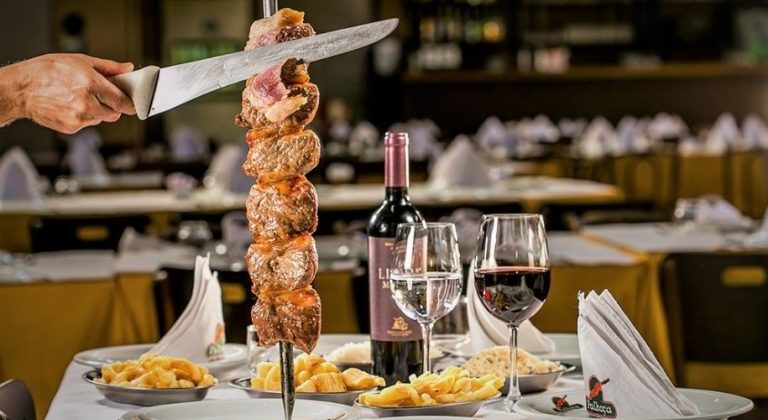
Varieties of Brazilian restaurant
Churrascaria – Brazilian barbecue
One of the types of all-you-can-eat restaurant in Brazil that is definitely worth a trip is the “churrascaria”. Expertly grilled meat is served alongside a selection of side-dishes. Especially popular is the “Rodizio”, these are the churrascarias which offer “all you can eat” buffets (note the dessert trolley is not always included). The waiters pass between the tables with the different cuts of meat, the serving is then sliced from the main cut directly onto the customers plate.
The sides take the form of a large buffet. There are lots of options ranging from simple sides like rice and fries to salads, sushi, soups and stews. Generally, the churrascarias have a good selection of local and imported wines in their cellars.
Portuguese terms for doneness:
Rare – Mal passado
Medium – No Ponto
Well done – Bem cozido
Some of the most popular cuts of beef are “picanha”, “maminha” and “fraldinha”. These are the rump cap, bottom sirloin and the confluence of the short loin, sirloin and flank respectively.

The Brazilian “Kilo Restaurant”
Another popular buffet option is known as the “Brazilian kilo restaurant.” As the name suggests, these restaurants serve food by the kilo (comida por quilo). You take what you want from the multiple options at the buffet, then your plate is weighed and the price is determined according to the weight (the price for 100g is indicated at the checkout). Some restaurants have several formulas and if you only take meat and salad for example, the price per kilo is a little higher. An average plate costs around 15 reais and upward.
Not to be confused with the “quentinha”, which is rice (arroz), dried beans and beef (boi or carne bovina) or chicken (frango) to take away. It is very good value at around 15 reais with a glass of fruit juice. Many popular restaurants offer buffet food by the kilo, you serve your side dishes yourself and the cook serves the protein portion of your choice.

Other types of Brazilian restaurant
You will also find restaurants with tasty regional dishes, particularly in the states of Bahia, Amazonia and Minas Gerais. These are interesting options for discovering the culinary specialties of each region. Like many aspects of Brazilian culture, the food is marked by Indigenous, African and European influences depending on the region. In these more traditional restaurants the dishes are very generous and normally come “para dois” (for two) with several side dishes.
São Paulo and Rio de Janeiro have some international award-winning restaurants. If you want to dine in these sorts of places, it is better to have a reservation made a few weeks in advance to guarantee having a table. The tolerance period for your reserved table in the event of delay is generally 20 minutes.
Bars in Brazil
Brazilians are very social and go out a lot at night, whether with family or friends. It is quite common for those with some disposable income to eat out a few times a week and even more often. This is especially true for the new generations of the urban middle class who tend to cook little. They buy a lot of prepared meals, go to dinner several times a week for pizzas, meat skewers or sandwiches in “Lanchonetes” and go out to bars and restaurants regularly.
As a result, in large cities fast food is very popular and bars also serve “pub grub” and bar snacks. Here these are called “petiscos” and they come in all shapes and forms, from classic potato or cassava fries (macaxeira) to “feijao verde” (dried beans cooked in sauce with cream and cheese), grilled meats, shrimp and dumplings stuffed with fish or cheese. Brazilians mainly drink light and very cold beer shared between the table in small glasses poured from a 600 ml bottle. Also popular of course, is the famous Caipirinha! Wine is expensive in Brazil and the cheaper local bottles are usually not of great quality. On the other hand, there are excellent wines from Chile and Argentina, as well as the more expensive Brazilian wines. For a nice bottle in a restaurant, you can expect to pay between $25 – $35.
Of course, Brazil is not home to Brazilian food only. The waves of immigrants that have entered the country have brought their culinary traditions and customs. Pizza and pasta came with the many Italian immigrants settled in the south of the country and have become very popular all over Brazil. The Asian cuisine is essentially dominated by Japanese influence (often tailored to Brazilian tastes), remember that Brazil is home to the largest Japanese diaspora in the world. We find the Syro-Lebanese influence with traditional Quibes that are popular in bars, lanchonetes and other eateries.
Specialities of Brazilian cuisine
Feijoada – The national dish of Brazil
Brazilians are lucky to have access to a myriad of ingredients which allows the national cuisine to be very varied and sometimes peculiar! In terms of specialities the most famous and well known Brazilian dish is the delicious “feijoada”. This is the national dish and it is made of black beans, salted and smoked pork, beef and sausages. It is a traditional recipe cooked for a long time in large, heavy bottom pots, similar to a Portuguese “cozido.” Academics have started to debate the long-standing theory that the dish was invented when African slaves in Brazil mixed the leftover pork from their master´s meals with the native black bean. It is served with rice, orange wedges and fried kale as an accompaniment. Feijoada is often eaten with a “batida” (a Brazilian fruit juice/smoothie mixed with cachaça. If there is a family meeting or a social gathering between friends at the weekend, there will usually be feijoada and you will find it from the North to the South of Brazil.

Brazilian gastronomy – Regional specialities
Each region of Brazil also has its own specialties, here are some not to be missed during your trip to Brazil.
What to eat in Bahia
In the rest of the Nordeste, it’s time for grilled tropical fish (peixe grelhado), “camarão” (shrimps) and “lagosta” (lobsters), fresh out of the surrounding reefs. Usually these seafood delights are lightly fried in a little garlic. Do not hesitate to try the many salt-water and fresh water fish, the morning´s catch with your feet in the sand!
The “sirigado” is one of the most sought after locally. The pargo (red snapper), the peixe amarelo, the beijupira, the ciubá and many other fish are available in the Nordeste, perfect for seafood diners. For the lobsters, choose them simply grilled, this is how they best reveal their full flavor. Be careful however, from December to June, you cannot fish for lobster so frozen catch is used.
Another specialty, typical of the Northeast and other farming regions of Brazil is carne de sol; semi-dried and salted beef that is cooked in Manteiga da terra (local liquid butter). It is also used to make escondidinho, a recipe similar to Shepherd’s Pie, made of ground carne de sol and manioc mash. Serve with cassava and “Baião de dois,” cooked rice with dried beans (feijão) and local soft cheese, typical of the Nordeste. Very popular in the coastal areas accompanied by a refreshing coconut water.
What to eat in Nordeste
In Bahia, the state most renowned for its African influenced cuisine, do not miss the local delights. Among them, the delightful “acarajé”- a traditional bean dumpling that is split and filled with sauces, small vegetables and shrimp. Acarajé is usually bought at small street-stands ran by women in immaculate and picturesque traditional dress.
Moqueca, is a fish and / or shrimp stew cooked in coconut milk and deliciously spiced with “azeite de dendé.” This traditional oil from the local palm tree is another typical Bahian specialty.
“Vatapa” is a thick cream prepared with bread crumbs that have been soaked in coconut milk, shrimp or chicken and a dash of azeite de dendé. A delicious and popular dish that is typically Bahian and Afro-Brazilian.
Bahians also have a reputation for making the tastiest chili sauces in Brazil!
What to eat in The Amazon
In the Amazon, you can be sure that you will discover exciting new flavors from the rivers and the surrounding forest. A must try are “Pirarucu” fillets, one of the largest freshwater fish in the world. Its distant cousin the delicious “Tambaqui” with its amazing “human” teeth is a classic from the Manaus region. It is especially eaten “na banda” which means that the fish is cut lengthways and the pieces grilled or fried.
Tacacá is a soup of indigenous origin that is found throughout the Amazon basin. Served in pretty local bowls called “cuia”, it is made with shrimp, cassava, tapioca gum and jambù. This plant adds a lot of complexity to any dish as it gives a sensation of slight tingling on the lips and tongue. The effect is amazing, adds to the meal and not at all unpleasant.
For dessert, in addition to the countless local fruits (we promise you will find something you have never heard of), you should definitely try the delicious Acaí sorbet. It has recently been exploding in popularity with fitness gurus all over the world because of its amazing nutritional properties. In Belém, acaí is eaten as part of the meal and less so as a desert, for example it is a popular side dish with a fried fish main. Also, it is prepared with less water and sugar, so it has a stronger more bitter taste.
Brazil – King of fresh fruit juice!
Wherever you are in Brazil, you can enjoy the wonderful local tropical fruit juices, they are delicious, healthy and made with real fruit. They remind you of smoothies that are fashionable in Europe and are always made with filtered or mineral water. A great way to discover new flavours, there are fruit juices available in places where the fruit itself is harder to come by.
In the Nordeste we particularly recommend these fruits which are difficult to find anywhere else.
Caja – A sweet and sour taste that is widely used for making smoothies and alcoholic cocktails.
Graviola – Also known as soursop, it has a thick creamy taste with citrus notes. Popular for making ice – cream and ice lollies. Has been said to cure cancer.
Acerola – A small red berry that can grow well in the arid Nordeste. It contains the world´s second highest Vitamin – C concentration after camu camu.
Caju – The fruit that bears the cashew nut! Juicy and a little acidic with a slightly dry finish.
Siriguela – A small very sweet fruit that is rich in anti – oxidants and free radicals.
Without forgetting the delicious classics found throughout Brazil – Manga (mango), Abacaxi (pineapple), Laranja (orange), goiaba (guava) and Maracuja (passion fruit)!
Transport in Brazil – Public transport, Taxis and Uber
In the tourist areas of Brazil, during the day public transport is generally safe. However, when you leave the built up areas this can change, not to mention the fact that you can get lost easily because there are sometimes no signs at the bus stops. This can make it difficult to quickly check the different lines passing through, their timetables and routes. Without speaking Portuguese, it can quickly become a headache. Some cities such as Rio de Janeiro have a metro network that is more easily accessible and very convenient for traveling around the tourist area. However, tourists are not advised to take it to reach the working-class neighborhoods on the outskirts.
During the day, it is no problem to walk around, as long as you respect a minimum of common sense and safety rules. In Brazilian cities, unless you are in crowded places such as seaside avenues or built up restaurant areas, it is a general rule that after dark or 8 p.m, the locals move around by vehicle rather than on foot. We recommend that travelers do the same.
Getting a taxi in Brazil
It is very easy to take taxis in Brazil and the drivers are often quite friendly. The cars are standardized and each city´s taxis have a particular color. Do not get into a car that advertises itself as a taxi but does not respect the local color code and have a licenced badge.
If you do not speak any Portuguese, it is best to inquire about the rough price of a ride at your hotel reception and ask the receptionist to order the cab for you. In Rio, there are tables which show you the average price of a ride between different destinations, distributed by the Tourist Office RIOTUR. On board, it is important to check the meter. It has 2 rates depending on the time:
“Bandeira 1” = the day rate between 6 am and 8 pm.
and
“Bandeira 2” = the night rate between 8 pm and 6 am, which is approximately 20% higher).
At airports, you can normally find special airport taxis which can be a good alternative to relying on the meter because they are paid in advance. To use them you buy a ticket at a counter in the hall – the price is determined by the area in which your destination address is located. Then you go to the dedicated parking lot and give your coupon in exchange for which the driver will drive you safely to your destination.
Using Uber in Brazil
It is very easy to take taxis in Brazil and the drivers are often quite friendly. The cars are standardized and each city´s taxis have a particular color. Do not get into a car that advertises itself as a taxi but does not respect the local color code and have a licenced badge.
If you do not speak any Portuguese, it is best to inquire about the rough price of a ride at your hotel reception and ask the receptionist to order the cab for you. In Rio, there are tables which show you the average price of a ride between different destinations, distributed by the Tourist Office RIOTUR. On board, it is important to check the meter. It has 2 rates depending on the time:
“Bandeira 1” = the day rate between 6 am and 8 pm.
and
“Bandeira 2” = the night rate between 8 pm and 6 am, which is approximately 20% higher).
At airports, you can normally find special airport taxis which can be a good alternative to relying on the meter because they are paid in advance. To use them you buy a ticket at a counter in the hall – the price is determined by the area in which your destination address is located. Then you go to the dedicated parking lot and give your coupon in exchange for which the driver will drive you safely to your destination.

Tipping in Brazil
Higher – end restaurants will charge a service charge of 10% that will appear at the end of your bill. Some hotels have porters who will take your bags, it is common to give them a 5 real tip per piece of luggage. They must be given to express satisfaction and are not mandatory. To give you an idea, the average salary is around 2,500 reals.
For an English – speaking guide, a tip of R$100 per full day would be satisfactory and very much appreciated.
For a satisfactory guide on a half-day excursion, between R$50 and R$100 is adequate.
For a driver between R$ 20 for a transfer and R$ 100 for a beach buggy driving in the Nordeste or transfers across Pantanal.
A note on punctuality in Brazil
Brazil is not Switzerland! The vision of punctuality here is not at all the same as in Europe. Some states, especially in the northern half of the country, see punctuality very differently from what Europeans or North Americans may. When you live in or visit these regions, it is absolutely not uncommon to have friends arrive nonchalantly more than an hour after an agreed meeting time. And, without warning!
Service providers that operate in international tourism emphasize punctuality and are normally on time. However, there can sometimes be delays in appointments that are set for you, in particular due to unforeseen traffic jams in the capitals.
In this case you have to have a little patience, and remind yourself that you are in a country with a different culture – that does not prevent professionalism. If the delay lasts more than twenty minutes, get in touch with your agency to take stock with it.
